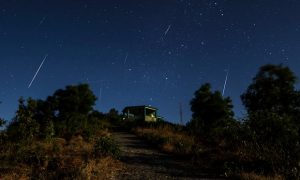Geminid meteor shower peaks tonight – here’s how to see it


The latest chapter of events in a galaxy far, far away isn’t the only thing worth staying up late for tonight in the UK. Just as cinema goers are pouring out of the midnight Star Wars showing, up in the (hopefully clear) skies above, the Geminid meteor shower will be reaching its climax in a solar system very, very close to us – our own, in fact.
Meteors burn up between 80 and 120km above our heads. This particular annual meteor shower has been getting more intense in recent years and between 2am and 3am tonight, an estimated 120-160 meteors could be seen.
It’s not just the UK that will see the shower. From the northern hemisphere, the meteors will emanate from high in the southwestern sky. From the southern hemisphere, low in the northwest. Although the shower peeks in the early hours, meteors should be visible all night.
This year, viewing conditions are particularly favourable because the Moon is a thin crescent, which will only rise an hour or so before dawn. With no moonlight to brighten the darkness for most of the night, even fainter meteors will be easily visible.
Meteors, more commonly termed shooting stars, are tiny pieces of dust that collide with our planet and burn up in the atmosphere. The annual meteor showers occurs when Earth ploughs through individual streams of cosmic dust. Each of these was once part of the tail of an icy comet. For example, the Orionid meteor shower in late October comes from dust grains that were expelled by the famous Halley’s comet.
The Geminids are somewhat unusual in that the dust comes from an extremely rare type of object called a ‘rock comet’. This particular rock comet is an asteroid called Phaethon. It dives towards the Sun every 523.5 days, passing inner planet Mercury and drawing within 21 million kilometres of our star’s blistering face.
The intense heat fractures Phaethon’s surface, rather like mud cracks in the bottom of a dry lake. Loose grains are blown off into space by the pressure of the sunlight, which overcomes the object’s extremely low gravity, and creates the tail. By contrast, in a comet the tail is created by ice and gas as well as dust.
Phaethon itself was discovered in 1983 and is about 5km in diameter. Until its discovery, the parent body of the Geminids was unknown.
Astronomers get a close-up look at Phaethon this Saturday, 16 December, when it makes its closest pass of Earth since its discovery. It will close to a distance of ‘just’ 10 million kilometres. This is twenty-six times further away than the Moon, so the chance of collision is absolutely zero. It will remain the rock comet’s closest approach until 2093.
Although not visible to the naked eye, Phaethon can be seen with home telescopes, and the correct charts and instructions. But the Geminids are for everyone. They can be seen with your naked eyes. So tonight, after the cinema, hope for clear skies, get away from streetlights, look up and may the force be with you.









